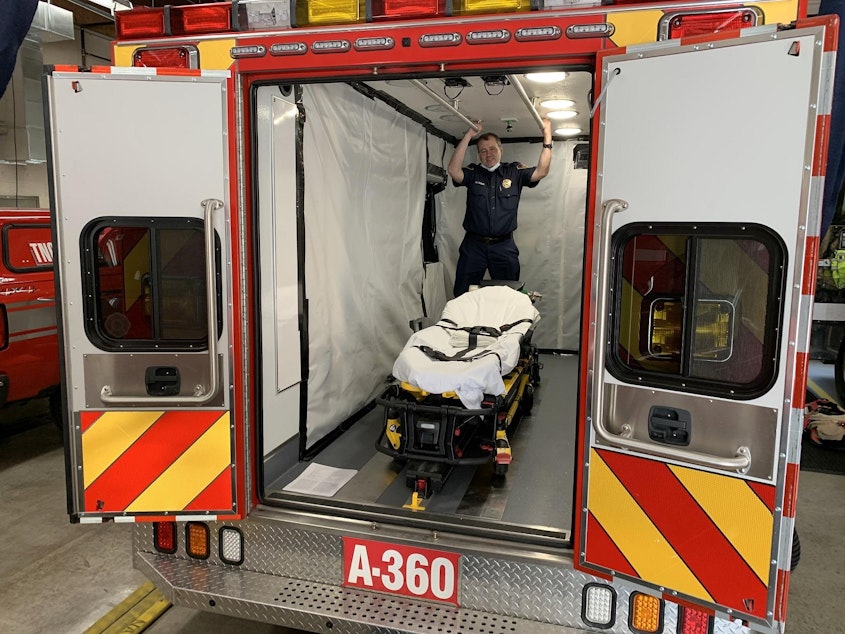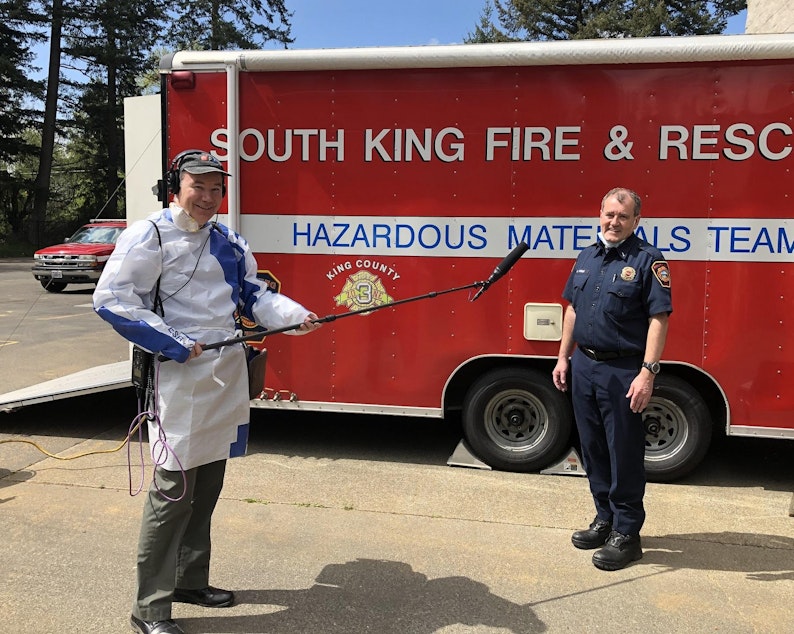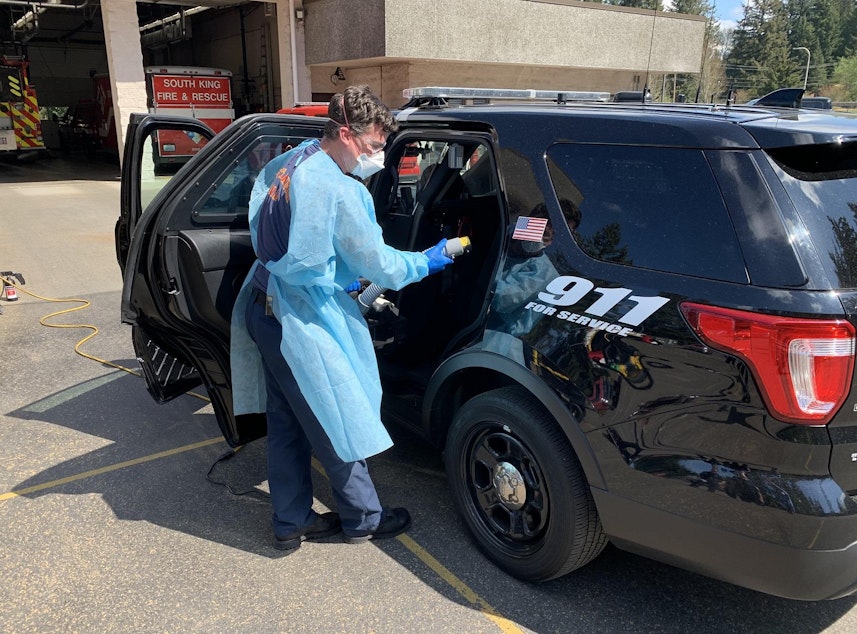Improvisation necessary for Pacific Northwest first responders facing Covid-19 threat

Coronavirus risk and ongoing shortages of personal protective equipment (PPE) are leading fire departments around the region to rediscover the enduring truth of the idiom, "Necessity is the mother of invention."
Since the virus epidemic emerged in the Pacific Northwest, the fire service has changed tactics, improvised and resorted to creativity to keep first responders healthy and available to serve the public.
"We had to make a number of changes to the way we do business. That started with dispatch," said Dennis Lawson, a Central Pierce Fire & Rescue battalion chief and president of the Washington State Council of Fire Fighters.
South King Fire & Rescue, a mid-sized department in the Seattle suburbs, is as good a place as any to see the rapid-fire invention and dissemination of best practices in the face of an invisible threat. During the middle of a workday, the dispatch radio is rarely quiet for long. The electronic alarm chimes that echo through the district's fire stations usually signal medical aid calls.
When the firefighter-EMTs arrive at a scene, they now approach differently than before the virus pandemic. Lt. Jan Nielsen described what has come to be known as the "scout" model for medical calls.
"It requires one person to don mask, eye covering, gloves and gown, go in and ask some questions that illuminate whether it is a high risk situation for COVID exposure," Nielsen said in an interview.
The other responders stay back until they learn how much precious protective gear is needed. New, widely-adopted 911 dispatch procedures for screening callers for signs of COVID-19 also help with situational awareness.
Sponsored
"Instead of having everybody go in in mask, eye (covering), gown and gloves, it allows us that if it is not a highly suspected call, then we save that PPE. Not everybody is wearing it," Nielsen explained.
Nielsen was one of three officers selected by his chief to serve on the department's COVID-19 problem-solving task force. Their top themes are fairly universal: Keeping the force safe and conserving protective gear that is hard to resupply.
"I said I want you to look at what we can do to take care of our people," South King Fire & Rescue Chief Vic Pennington said about the mission he gave his officers. "We have to have a healthy workforce so we can go out and deliver the service that we need to."
"There is a shortage of personal protective equipment, so we have had to come up with ways to find some, to create our own, to figure out how we can get some longevity out of the ones that we have," Pennington said.
Lt. Greg Willett is another officer on the task force who is improvising ways for his department to stay safe amid the coronavirus.
Sponsored
"Yeah, give me a rubber band and some paper clips," Willett said cheerfully. "That is kind of what we're doing. You know, with limited resources coming up with solutions."
Willett has ordered a hydrogen peroxide vaporizer to make a chamber to decontaminate masks for reuse. Other departments including Spokane and Kirkland, Washington, have procured ultraviolet light boxes to sterilize masks to use again.
Nielsen came up with an idea to make homemade protective gowns out of Tyvek house wrap. Inmates at the Washington state prison for women in Purdy are now sewing the alternative medical gowns for the South King Fire department from rolls of donated house wrap.

Willett used other common hardware supplies to modify an aid car for transport of COVID-19 patients.
Sponsored
"This is just rolls of polyethylene and basically some Gorilla tape," Willett said as he swung open the rear doors of the medic unit to show how the inside walls around the stretcher are all covered with plastic film.
"It looks almost like we're making a haunted house or something," Willett said with a chuckle. "I learned this technique first for something like Ebola."
Training for prior feared infectious diseases like SARS and Ebola turned out not to be needed locally back then, but is coming in handy now. In Oregon, Lane County EMS agencies and the Salem Fire Department have also created plastic envelopes inside medic units designated for COVID-19 transports.
"That's an effort to minimize the amount of disinfection later and prevent respiratory droplets from getting into the driver's compartment, under handles, into drawers and nooks and crannies," explained Michael Heffner, assistant chief deputy with the Oregon Office of State Fire Marshal.
Outside of South King Fire & Rescue Station 61, Willett showed how the department's existing hazardous materials response trailer and portable showers are now repurposed as a COVID-19 decontamination station. On Monday, Des Moines, Washington, police officer Justin Cripe stopped by to have his patrol car disinfected.
Sponsored
"Having this tool I think gives a sense of relief to a lot of officers, knowing that if we go into a situation where we could be exposed, we have tools like this to keep us both safe and healthy afterwards," Cripe said.
"There's always the unknown that you tend to think about at the end of a call," added Des Moines Police Officer Mark Hake. "You have to think about, well jeez, is it possible I may have been exposed? It weighs on your mind."
After Cripe and Hake pulled up and stepped aside, a hazmat technician filled the patrol car with a disinfectant mist using a portable atomizer that sounded like a vacuum cleaner running in reverse. The aerosol is billed as capable of killing any coronavirus within three minutes.

Units from the Renton, Des Moines and Federal Way police departments, King County Sheriff and King County Medic One have availed themselves of the decon service since it opened last month.
Sponsored
A decontamination station for partner agencies is an unusual innovation for the age of coronavirus, but a lot of the other tactics are shared with first responders around the nation. In early March in Oregon, the Office of State Fire Marshal, the Oregon Fire Chiefs Association, Oregon State Firefighters Council and a few others formed the Oregon Fire Service Coronavirus Response Team to swap ideas and provide guidance.
"They have worked together to create best practices and push out that messaging and connect stakeholders to resources," Heffner said. "We have taken lessons from our neighbors in Washington and California that were earlier in the curve."
The South King Fire officers on their department’s COVID-19 task force brought diverse backgrounds to the table. Willett, the hazmat guy, likes to sign up for all sorts of speciality training classes and as a result had a grounding in highly-infectious disease response. Nielsen joined the fire service after getting close to becoming a geophysics professor, which resulted in an analytical mind grafted to tinkering skills.
The third officer of the trio, Capt. Shane Smith, brought high-level incident management experience from previous deployments to disasters such as the deadly 2014 Oso landslide in Snohomish County and California wildfires. Ironically, Smith had to self-isolate for the past two weeks after contracting COVID-19 himself from an unknown source.
"They've exceeded my expectations by ten-fold at least," said Chief Pennington. "I'm really proud of our firefighters."

